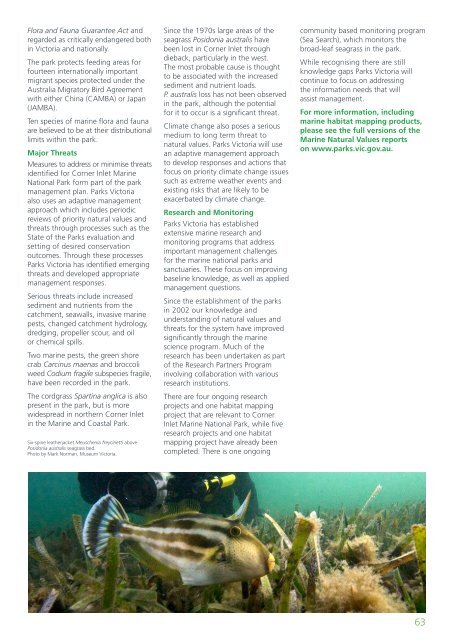Marine Natural Values Study Summary - Parks Victoria
Marine Natural Values Study Summary - Parks Victoria
Marine Natural Values Study Summary - Parks Victoria
Create successful ePaper yourself
Turn your PDF publications into a flip-book with our unique Google optimized e-Paper software.
Flora and Fauna Guarantee Act andregarded as critically endangered bothin <strong>Victoria</strong> and nationally.The park protects feeding areas forfourteen internationally importantmigrant species protected under theAustralia Migratory Bird Agreementwith either China (CAMBA) or Japan(JAMBA).Ten species of marine flora and faunaare believed to be at their distributionallimits within the park.Major ThreatsMeasures to address or minimise threatsidentified for Corner Inlet <strong>Marine</strong>National Park form part of the parkmanagement plan. <strong>Parks</strong> <strong>Victoria</strong>also uses an adaptive managementapproach which includes periodicreviews of priority natural values andthreats through processes such as theState of the <strong>Parks</strong> evaluation andsetting of desired conservationoutcomes. Through these processes<strong>Parks</strong> <strong>Victoria</strong> has identified emergingthreats and developed appropriatemanagement responses.Serious threats include increasedsediment and nutrients from thecatchment, seawalls, invasive marinepests, changed catchment hydrology,dredging, propeller scour, and oilor chemical spills.Two marine pests, the green shorecrab Carcinus maenas and broccoliweed Codium fragile subspecies fragile,have been recorded in the park.The cordgrass Spartina anglica is alsopresent in the park, but is morewidespread in northern Corner Inletin the <strong>Marine</strong> and Coastal Park.Six-spine leatherjacket Meuschenia freycinetti abovePosidonia australis seagrass bed.Photo by Mark Norman, Museum <strong>Victoria</strong>.Since the 1970s large areas of theseagrass Posidonia australis havebeen lost in Corner Inlet throughdieback, particularly in the west.The most probable cause is thoughtto be associated with the increasedsediment and nutrient loads.P. australis loss has not been observedin the park, although the potentialfor it to occur is a significant threat.Climate change also poses a seriousmedium to long term threat tonatural values. <strong>Parks</strong> <strong>Victoria</strong> will usean adaptive management approachto develop responses and actions thatfocus on priority climate change issuessuch as extreme weather events andexisting risks that are likely to beexacerbated by climate change.Research and Monitoring<strong>Parks</strong> <strong>Victoria</strong> has establishedextensive marine research andmonitoring programs that addressimportant management challengesfor the marine national parks andsanctuaries. These focus on improvingbaseline knowledge, as well as appliedmanagement questions.Since the establishment of the parksin 2002 our knowledge andunderstanding of natural values andthreats for the system have improvedsignificantly through the marinescience program. Much of theresearch has been undertaken as partof the Research Partners Programinvolving collaboration with variousresearch institutions.There are four ongoing researchprojects and one habitat mappingproject that are relevant to CornerInlet <strong>Marine</strong> National Park, while fiveresearch projects and one habitatmapping project have already beencompleted. There is one ongoingcommunity based monitoring program(Sea Search), which monitors thebroad-leaf seagrass in the park.While recognising there are stillknowledge gaps <strong>Parks</strong> <strong>Victoria</strong> willcontinue to focus on addressingthe information needs that willassist management.For more information, includingmarine habitat mapping products,please see the full versions of the<strong>Marine</strong> <strong>Natural</strong> <strong>Values</strong> reportson www.parks.vic.gov.au.63
















